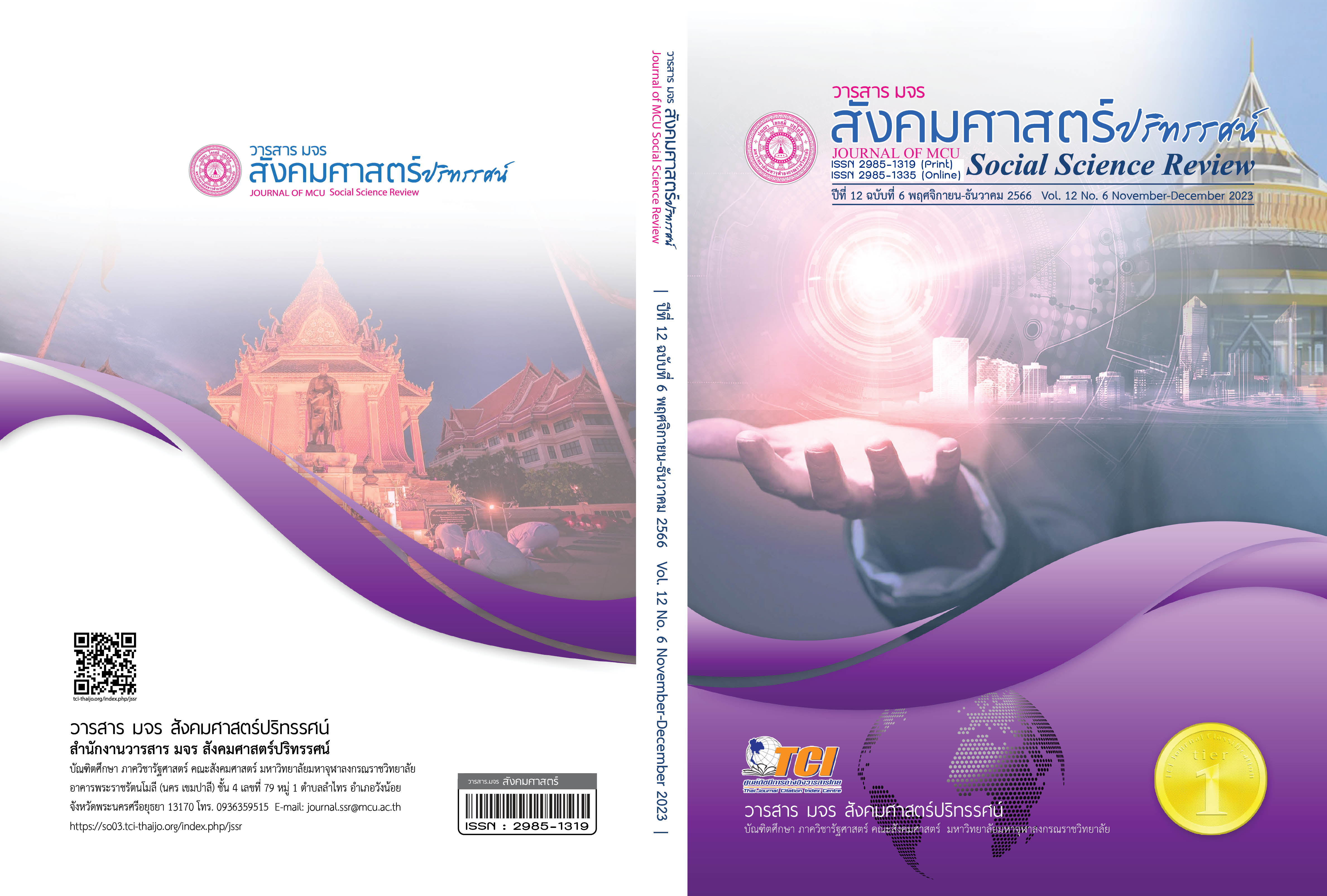การพัฒนาการท่องเที่ยวเชิงนิเวศศิลป์อย่างมีส่วนร่วมในพื้นที่ ตำบลวังไม้ขอน อำเภอสวรรคโลก จังหวัดสุโขทัย
คำสำคัญ:
การมีส่วนร่วม, การท่องเที่ยวเชิงนิเวศ, นิเวศศิลป์บทคัดย่อ
บทความวิจัยนี้มีวัตถุประสงค์ 1. เพื่อส่งเสริมการท่องเที่ยวเชิงนิเวศศิลป์อย่างมีส่วนร่วมและ 2. พัฒนาองค์ความรู้และสินค้าชุมชนจากวัสดุเหลือใช้และวัสดุธรรมชาติในพื้นที่ตำบลวังไม้ขอน อำเภอสวรรคโลก จังหวัดสุโขทัย โดยเป็นการวิจัยแบบมีส่วนร่วมกับผู้มีส่วนเกี่ยวข้องในพื้นที่ ได้แก่ตัวแทนจากองค์การบริหารส่วนตำบลวังไม้ขอน ผู้ประกอบการการท่องเที่ยวชุมชน ได้แก่ โรงนาบ้านไร่ พระจากวัดจันทโรภาสเกษตรกร เยาวชนและผู้สูงอายุ จำนวน 20 คน และการเก็บรวบรวมข้อมูลจากเอกสาร การสัมภาษณ์บุคคลและการถอดบทเรียนร่วมกัน โดยใช้วิธีการวิเคราะห์เนื้อหา
ผลการวิจัยพบว่า 1. นำไปสู่การจัดการองค์ความรู้ประวัติศาสตร์ของตำบลวังไม้ขอนและเมืองสวรรคโลก แผนที่ท่องเที่ยวชุมชน และการพัฒนาพื้นที่ลานนิเวศศิลป์ ณ วัดจันทโรภาส ซึ่งนำไปสู่การส่งเสริมการท่องเที่ยวเชิงนิเวศของชุมชนอย่างมีส่วนร่วมและ 2. นำไปสู่การเกิดองค์ความรู้และกิจกรรมแบบนิเวศศิลป์และการเพิ่มมูลค่าสินค้าชุมชนจากวัสดุเหลือใช้และวัสดุธรรมชาติ คือ เม็ดสีดินพระร่วง ซึ่งเป็นองค์ความรู้ใหม่และนำไปสู่การถ่ายทอดองค์ความรู้ให้แก่ชุมชนอื่นในจังหวัดสุโขทัยต่อไป
เอกสารอ้างอิง
กรีน เน็ตเวิร์ค. (2562). Upcycle และ Recycle วิถีแห่งความยั่งยืน. สืบค้น 10 มีนาคม 2564, จาก https://www.greennetworkthailand.com
ชุลีรัตน์ จันทร์เชื้อ และคณะ. (2558). การค้นหาเครือข่ายการจัดการท่องเที่ยวโดยชุมชนด้วยกระบวนการงานวิจัยเพื่อท้องถิ่นสู่การสร้างโครงข่ายการท่องเที่ยวโดยชุมชนภาคเหนือตอนล่าง (รายงานการวิจัย). กรุงเทพฯ: สำนักงานกองทุนสนับสนุนการวิจัย.
ทวี สุขโข และคณะ. (2560). การจัดการท่องเที่ยวเชิงวัฒนธรรมบ้านดอนข่าโดยการมีส่วนร่วมของชุมชน หมู่ 7 ตำบลชนบท อำเภอชนบท จังหวัดขอนแก่น (รายงานการวิจัย). กรุงเทพฯ: สำนักงานกองทุนสนับสนุนการวิจัย.
ป้อ วชิรวงศ์วรกุล. (2554). แนวทางการพัฒนาศักยภาพชุมชนในการจัดการท่องเที่ยวโดยชุมชนบ้านร่องกล้า ตำบลเนินเพิ่ม อำเภอนครไทย จังหวัดพิษณุโลก (รายงานการวิจัย). กรุงเทพฯ: สำนักงานกองทุนสนับสนุนการวิจัย.
ปิรันธ์ ชิณโชติ และธีระวัฒน์ จันทึก. (2559). รูปแบบการจัดการการท่องเที่ยวเชิงสร้างสรรค์ของสวนผึ้ง. Veridian E-Journal, Silpakorn University, 9(1), 250-268.
พยุงพร นนทวิศรุต และคณะ. (2560). การมีส่วนร่วมในการจัดการท่องเที่ยวเชิงวัฒนธรรมชุมชนนาหอ อำเภอด่านซ้าย จังหวัดเลย (รายงานการวิจัย). กรุงเทพฯ: สำนักงานกองทุนสนับสนุนการวิจัย.
พศุตม์ กรรณรัตนสูตร. (2560). การสร้างสรรค์ผลงานศิลปะแนวสื่อผสมจากวัสดุเหลือใช้ประเภทโลหะเพื่อสร้างสำนึกรักสิ่งแวดล้อม. กรุงเทพฯ: กระทรวงวัฒนธรรม.
ยศ สันสมบัติ. (2544). มนุษย์กับวัฒนธรรม. กรุงเทพฯ: สำนักพิมพ์มหาวิทยาลัยธรรมศาสตร์.
สันติชัย เอื้อจงประสิทธิ์. (2551). สาระสำคัญของการมีส่วนร่วมของบุคลากร. กรุงเทพฯ: สามเจริญพาณิชย์.
Megan, E.W. (2002). Ecotourism: principles, practice & policies for sustainability. Retrieved March 10, 2021, from https://www.unep.org/resources
ดาวน์โหลด
เผยแพร่แล้ว
รูปแบบการอ้างอิง
ฉบับ
ประเภทบทความ
สัญญาอนุญาต
ลิขสิทธิ์ (c) 2023 วารสาร มจร สังคมศาสตร์ปริทรรศน์

อนุญาตภายใต้เงื่อนไข Creative Commons Attribution-NonCommercial-NoDerivatives 4.0 International License.
เพื่อให้เป็นไปตามกฎหมายลิขสิทธิ์ ผู้นิพนธ์ทุกท่านต้องลงลายมือชื่อในแบบฟอร์มใบมอบลิขสิทธิ์บทความให้แก่วารสารฯ พร้อมกับบทความต้นฉบับที่ได้แก้ไขครั้งสุดท้าย นอกจากนี้ ผู้นิพนธ์ทุกท่านต้องยืนยันว่าบทความต้นฉบับที่ส่งมาตีพิมพ์นั้น ได้ส่งมาตีพิมพ์เฉพาะในวารสาร มจร สังคมศาสตร์ปริทรรศน์ เพียงแห่งเดียวเท่านั้น หากมีการใช้ภาพหรือตารางหรือเนื้อหาอื่นๆ ของผู้นิพนธ์อื่นที่ปรากฏในสิ่งตีพิมพ์อื่นมาแล้ว ผู้นิพนธ์ต้องขออนุญาตเจ้าของลิขสิทธิ์ก่อน พร้อมทั้งแสดงหนังสือที่ได้รับการยินยอมต่อบรรณาธิการ ก่อนที่บทความจะได้รับการตีพิมพ์ หากไม่เป็นไปตามข้อกำหนดเบื้องต้น ทางวารสารจะถอดบทความของท่านออกโดยไม่มีข้อยกเว้นใดๆ ทั้งสิ้น





